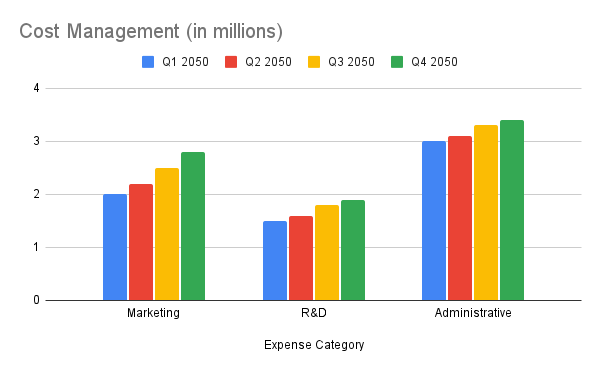Free Operational Business Review Template
Operational Business Review
Prepared by: [Your Name]
Executive Summary
The Operational Business Review (OBR) for the year 2050 provides an in-depth analysis of the [Your Company Name]’s operational performance. This report evaluates key performance indicators (KPIs), assesses the effectiveness of current strategies, and identifies areas for improvement.
Objectives
-
Assess overall operational performance.
-
Identify and analyze operational inefficiencies.
-
Review and evaluate strategic initiatives.
-
Recommend actionable improvements.
Key Performance Indicators (KPIs)
Revenue Growth
|
Quarter |
Revenue ($M) |
Previous Quarter Growth (%) |
Year-to-Date Growth (%) |
|---|---|---|---|
|
Q1 2050 |
12.5 |
- |
- |
|
Q2 2050 |
15.3 |
22.4 |
22.4 |
|
Q3 2050 |
18.0 |
17.6 |
26.0 |
|
Q4 2050 |
21.8 |
21.1 |
24.9 |
Operational Efficiency
|
Metric |
Q1 2050 |
Q2 2050 |
Q3 2050 |
Q4 2050 |
|---|---|---|---|---|
|
Average Processing Time (hrs) |
4.2 |
3.9 |
3.7 |
3.5 |
|
Cost of Goods Sold (COGS) ($M) |
6.0 |
7.2 |
8.0 |
8.5 |
Customer Satisfaction
|
Metric |
Q1 2050 |
Q2 2050 |
Q3 2050 |
Q4 2050 |
|---|---|---|---|---|
|
Net Promoter Score (NPS) |
62 |
65 |
68 |
70 |
|
Customer Complaints (Number) |
25 |
22 |
18 |
15 |
Employee Productivity
|
Metric |
Q1 2050 |
Q2 2050 |
Q3 2050 |
Q4 2050 |
|---|---|---|---|---|
|
Output per Employee ($) |
15,000 |
16,200 |
17,000 |
17,800 |
|
Employee Turnover Rate (%) |
8.5 |
7.8 |
7.2 |
6.9 |
Strategic Initiatives Review
Current Strategies
|
Strategy |
Description |
Status |
|---|---|---|
|
Digital Transformation |
Implementation of new ERP system |
Ongoing |
|
Market Expansion |
Entry into Asian markets |
Successful |
|
Product Diversification |
Launch of new eco-friendly product line |
In Progress |
Initiative Outcomes
|
Initiative |
Successes |
Challenges |
|---|---|---|
|
Digital Transformation |
Enhanced operational efficiency |
Integration issues with legacy systems |
|
Market Expansion |
Increased market share in Asia |
Cultural and regulatory adjustments needed |
|
Product Diversification |
Positive customer feedback |
Supply chain disruptions |
Adjustments and Refinements
|
Initiative |
Adjustments |
Future Action Plans |
|---|---|---|
|
Digital Transformation |
Further integration support |
Complete ERP roll-out |
|
Market Expansion |
Strengthen local partnerships |
Increase marketing efforts in new regions |
|
Product Diversification |
Improve supply chain management |
Diversify suppliers and logistics |
Operational Efficiency Analysis
Process Optimization
|
Process |
Improvement Implemented |
Impact |
|---|---|---|
|
Order Fulfillment |
Automated inventory management system |
15% reduction in processing time |
|
Customer Service |
Introduced AI-driven chat support |
20% decrease in response time |
Technology Utilization
|
Technology |
Effectiveness |
Opportunities for Upgrade |
|---|---|---|
|
ERP System |
Improved data integration |
Explore AI-enhanced analytics |
|
CRM Software |
Enhanced customer insights |
Upgrade to cloud-based solution |
Cost Management
|
Expense Category |
Q1 2050 |
Q2 2050 |
Q3 2050 |
Q4 2050 |
|---|---|---|---|---|
|
Marketing |
2.0 M |
2.2 M |
2.5 M |
2.8 M |
|
R&D |
1.5 M |
1.6 M |
1.8 M |
1.9 M |
|
Administrative |
3.0 M |
3.1 M |
3.3 M |
3.4 M |

Risk Management
Identified Risks
|
Risk |
Description |
Potential Impact |
|---|---|---|
|
Supply Chain Disruptions |
Dependence on single supplier |
Delays and increased costs |
|
Regulatory Changes |
New compliance requirements |
Additional operational costs |
Mitigation Strategies
|
Risk |
Existing Measures |
Recommendations |
|---|---|---|
|
Supply Chain Disruptions |
Identified alternative suppliers |
Develop contingency plans |
|
Regulatory Changes |
Ongoing compliance reviews |
Invest in regulatory advisory services |
Recommendations
Operational Improvements
-
Implement additional automation in warehousing to further reduce processing times.
-
Enhance employee training programs to increase productivity.
Strategic Adjustments
-
Accelerate the rollout of the new product line to capitalize on market trends.
-
Increase focus on digital marketing to drive further expansion in new markets.
Resource Allocation
-
Reallocate budget towards technology upgrades to support long-term growth.
-
Adjust marketing spend to focus on high-return channels.
Conclusion
The Operational Business Review for 2050 highlights a strong performance with notable successes in revenue growth and strategic initiatives. Continued focus on process optimization, strategic adjustments, and effective risk management will be key to sustaining and enhancing operational efficiency.